Intel Core 2 CULV Roundup: Who Needs Atom?
by Jarred Walton on February 4, 2010 4:00 AM ESTGeneral Performance: Atom Gets Dusted
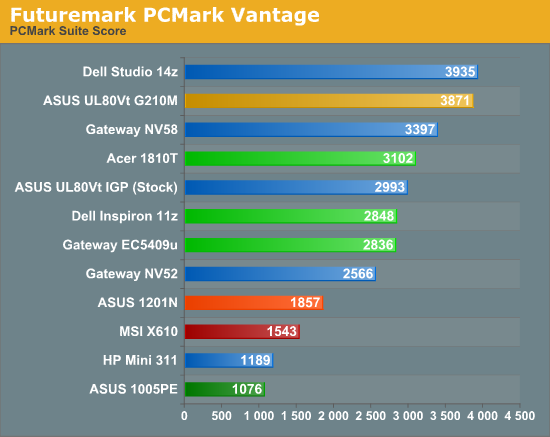
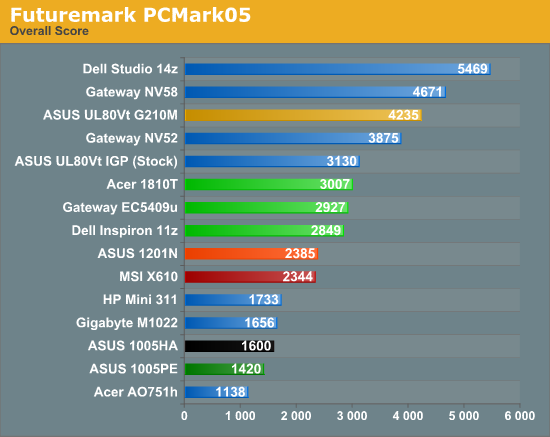
We've shown most of these results in our ASUS 1201N review, but where we were comparing dual-core Atom 330 to Atom N280 and N450, let's now focus on CULV performance. Starting with PCMark, we immediately see a very large performance gap. This isn't some synthetic divide, either: you will very much notice the performance boost moving from Atom N450 to the 1201N, and you'll feel it even more if you compare CULV to Atom N450. Even the Atom 330 is still a big drop in PCMark Vantage, where it's 35% slower than the EC5409u. PCMark05 shows a smaller difference of around 17%, but PCMark05 is relatively outdated now (as the 2005 year indicates).
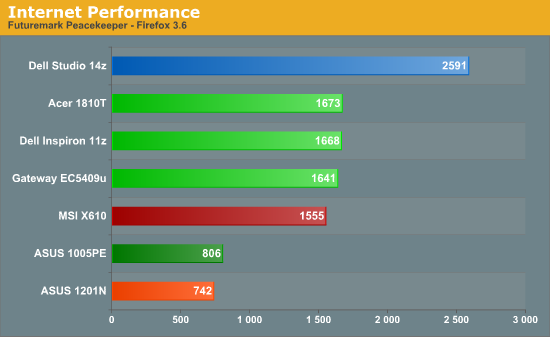
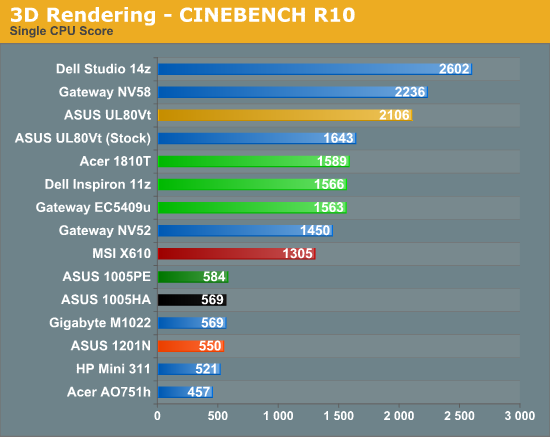
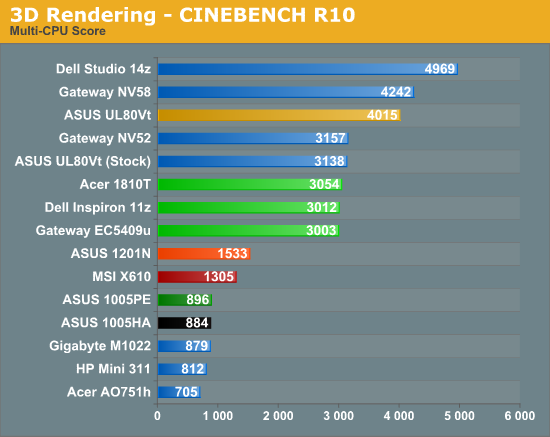
Next up we have Internet Surfing performance measured by the Futuremark Peacekeeper benchmark using Firefox 3.6. Peacekeeper is single-threaded in nature, taxing only one CPU core, but this is quite realistic for many non-video websites. Here the Atom 330 is hurt by its lower clock speed relative to N280/N450, and the jump to CULV roughly doubles performance. If you tend to surf simple text/image sites, the gulf may not be quite so large, but on most modern websites there's a clear difference between rendering times on Atom compared to CULV.
Similarly, CINEBENCH allows us to show quite clearly the difference between single-threaded and multi-threaded tasks. In single CPU mode, the CULV laptops are about 2.5 times as fast as Atom - N280, N450, or 330 doesn't matter. In tasks that can use multiple threads efficiently, the gap between CULV and Atom 330 closes a bit. CULV is still nearly twice as fast as the 330, but it's also 3.35 times as fast as N450. Remember that the multi-threading on N450 is actually Hyper-Threading (SMT) rather than two complete CPU cores, so this is expected.
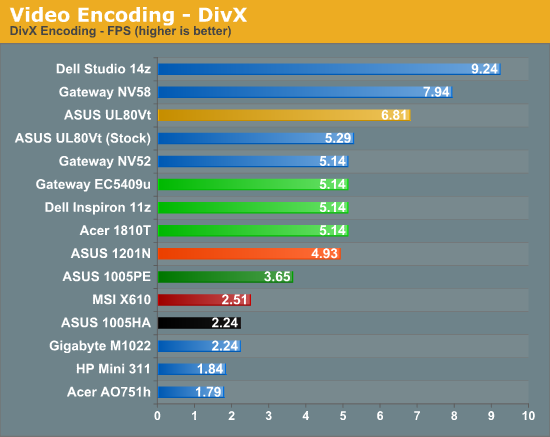
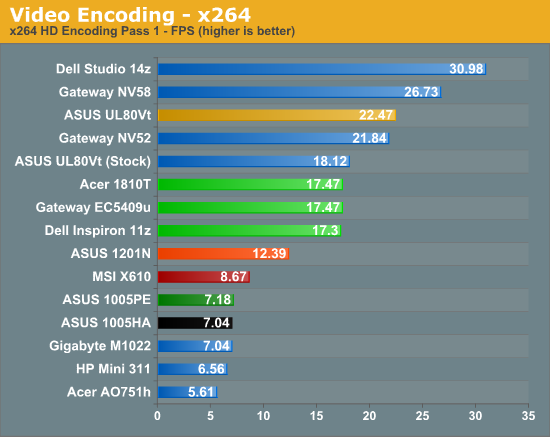
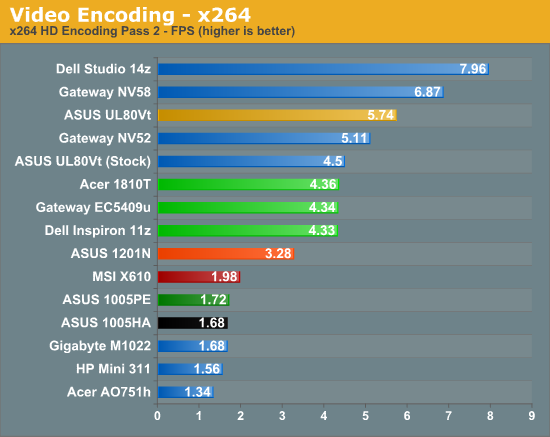
Wrapping things up with some heavily threaded video encoding tests, the four threads on 330 can at times come close to a 1.3GHz CULV. The best result is in DivX encoding where the 330 is only 4% slower than the various CULV laptops. x264 is more strenuous and the CULV offerings are 30~40% faster than Atom 330. Meanwhile, the "new and improved" Atom N450 shows only a very small improvement relative to N280, with CULV still delivering about 2.5 times the performance.
So as you would expect, the performance comparison between Atom and CULV is a lopsided affair. Atom is about keeping costs and power requirements low, and performance just isn't a major concern. Yes, it can run Windows 7, but you wouldn't want an Atom-based system to be your primary computer if at all possible. Given the pricing, you also wouldn't want to spend much over $300 unless you really like some of the other features on an Atom netbook (e.g. perhaps the chassis and build quality are a lot better than the competition). For the most part, Atom wins the price wars, but what about power and battery life?










62 Comments
View All Comments
tno - Friday, February 5, 2010 - link
Jarred,Again, I am not writing to instill any ill will. But technical content is only half of the product. Grammar and style are not mutually exclusive, and the proof of this is the use of style guides like the MLA, or Strunk and White, or even that of fellow online publication Engadget. These guides do more than just tell you where to use a comma; they seek to elevate and standardize the quality of writing for a publication.
Now I am all for introducing personal style to an article. And I am always impressed with the technical fidelity and content of AT writing. AT articles are more than just spec sheets and test results; they are pieces of writing. Arguing that omission of the preposition connecting two nouns is a matter of style is ignoring proper grammar with no gain. It is inexcusable for the writing component of any AT articles to be neglected, even if the technical content is of a high caliber.
Again, I am not trying to cause you any grief, nor imply that your writing is insufficient for inclusion on AT. I am simply pointing out that a small amount of editing and proofreading could go along way to improve all of AT's coverage.
I believe that this discussion has probably moved beyond the scope of the comments section and invite you to look-up my email through the forums if you would like to continue discussing this.
tno
JarredWalton - Friday, February 5, 2010 - link
Sadly (I suppose) I'm usually the one doing editing of other articles. It's much more difficult to edit your own content, especially after you've been over it ten times in the process of writing.But seriously, I find it astonishing that out of all the articles written on AnandTech and all the mistakes present in said articles, you would choose to complain about something so innocuous as "A couple years back" vs. "A couple of years back". We could also rephrase it "Just over two years ago" and it would be correct. I suppose http://www.thefreedictionary.com/couple">I'm in the minority when dropping the "of", though again I prefer to stick with informal styles for the most part.
At least we're not having a discussion about my use of "everything but" vs. "everything except"... or was that you as well? LOL
aapocketz - Thursday, February 4, 2010 - link
Back when the macbook Air came out these CULV processor laptops were $2000+, now they have dropped in price and could cannibalize high end netbooks. They are even being confused with netbooks now; consider the new Alienware m11x keeps being called a netbook, even though it uses a CULV.I have had similar thoughts, and almost purchased a Thinkpad x301 recently for under $800. The only reason I held back was I know these CULV chips are a couple years old now, and there are new I5 and I7 chips coming out soon, forcing prices down even further. When the Core2 CULV ultralights are sub $500, why buy these (bloated) netbooks for similar price? Netbooks originally were supposed to be around $200 or less though.
Also these ultralights have a few more little perks than the netbooks have, like backlit keys (or a "thinklight") - there is not a single netbook with a backlit keyboard.
Shadowmaster625 - Thursday, February 4, 2010 - link
Why dont you compare the $400 CULV notebooks with the netbooks, since that is the direct competition? Also there should be a Sempron M100 in here somewhere.macs - Thursday, February 4, 2010 - link
What about arrandale ULV? Asus UL30JT is coming soon and he brings core I7-620 ULV and NVIDIA 310M GPU. Should be great!I want something better than my atom netbook, maybe with a 11.6" screen but I want to wait those new Nehalem ULV...
Visual - Thursday, February 4, 2010 - link
I would love to see also the Acer 1420P / 1820P variants - no need to explore their tablet functionality in this comparison as it is off-topic, but do compare their keyboards, build quality and especially screen quality to the other non-touchscreen options. I've always wondered if touchscreen panels have a noticeably different visual quality.Also, if I understand correctly all these "current" CULVs are old Core 2/Penryn based, and as such are already old tech despite being launched in the products that you view only very recently. Shouldn't they get replaced with new Nehalem-generation 32nm processors any time soon? Or am I misunderstanding something?
Intel's code names and roadmaps are making my head hurt right now, so I'd really like to know your say on the matter - is there something in the same segment that is worth waiting for on the horizon?
QuietOC - Thursday, February 4, 2010 - link
The CULVs are all "old" 45nm Penyrn-3M/Wolfdale-3M 82 mm² dies--same core as the desktop E3x0 Celerons, E5x0/E6x0 Pentium Dual Cores, and E7x0 Core 2 Duos. The significant difference is that the CULV SpeedStep goes down to a 4x CPU multiplier during idle, my desktop Wolfdale-3Ms only go down to 6x. The Atom N270 also only goes down to a 6x multiplier.JarredWalton - Thursday, February 4, 2010 - link
Arrandale ULV parts have been announced, but nothing has shipped yet. I'm hoping to get one some time in the next month or two. One thing with the Arrandale ULVs is that they have a TDP of 18W compared to 10W. Obviously part of that is the integration of the new IGP, but there's definitely a question of how low their idle power draw can go. I suspect the initial Arrandale ULV parts will use slightly more power than the current Penryn parts.Performance is the other question we'll need to answer. Price wise, the newer Arrandale ULV chips run at a stock speed that's slightly lower than SU4100/SU7300 (1.06GHz and 1.20GHz for the http://www.anandtech.com/mobile/showdoc.aspx?i=370...">latest chips), and they also cost quite a bit more than SU4100. But yes, I am very interested to get some new ULV parts for review.
GTaudiophile - Thursday, February 4, 2010 - link
Anand,Out of curiosity, why not compare with the AMD Turion / Neo / X2 processors by chance?
OMG Snarf - Thursday, February 4, 2010 - link
I've got to agree with this. For the price point of the systems being benched, you can pick up an Athlon Neo X2 for $500, or a Turion Neo X2 for $600, direct from Toshiba with no shipping. Obviously the battery life won't be as good compared to the Intel CULVs, but I would be curious to see how the 12cell stacks up too. With the added $150 cost of the battery, you hit the same costs as the Intel CULV systems ($650), but get a Radeon 3200 instead of the anemic Intel 4500.